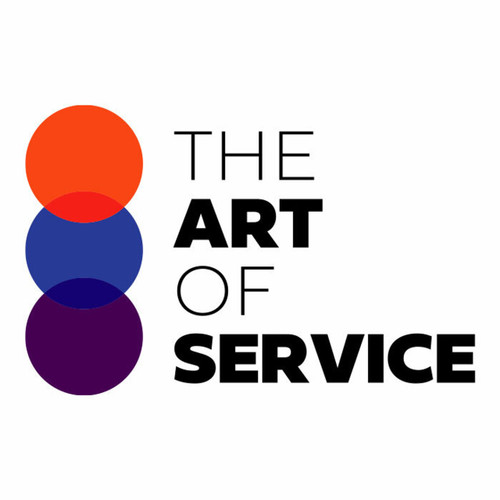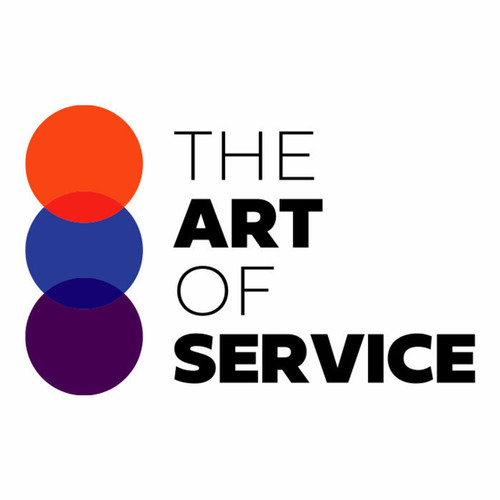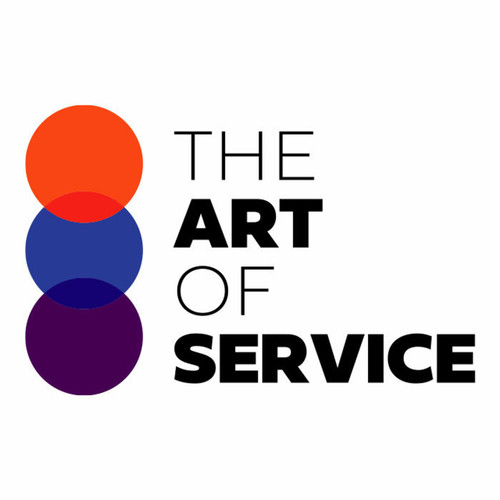Our Automation Testing in Internet of Things (IoT), Transforming Industries Knowledge Base has everything you need to streamline your testing processes and get results in record time.
With over 1500 prioritized requirements, solutions, benefits, and examples, our dataset is the most comprehensive and up-to-date resource for any professional looking to excel in the world of IoT testing.
Our product goes beyond just providing a list of questions to ask – it offers a complete guide on urgency and scope, giving you the tools to make informed decisions and achieve optimal results.
Compared to other alternatives and competitors, our Automation Testing in Internet of Things (IoT), Transforming Industries dataset stands out as the top choice for professionals.
It caters to a wide range of industries, making it a versatile tool for any business.
Our product is easy to use and affordable, making it accessible for all levels of users.
Our detailed specification overview provides a clear understanding of the product and its features, making it easy to navigate and utilize.
With our dataset, you will have access to in-depth research on the latest automation testing trends in IoT, allowing you to stay ahead of the curve and maintain a competitive edge.
But that′s not all – our Automation Testing in Internet of Things (IoT), Transforming Industries Knowledge Base also caters to businesses, helping them optimize their testing processes and cut costs.
With a clear breakdown of the pros and cons of different testing methods, our product empowers businesses to make informed decisions based on their specific needs and objectives.
Don′t waste any more time and resources on inefficient testing methods.
Let our Automation Testing in Internet of Things (IoT), Transforming Industries Knowledge Base revolutionize your testing process and help you achieve results like never before.
Purchase now and experience the power of streamlined, effective testing.
Discover Insights, Make Informed Decisions, and Stay Ahead of the Curve:
Key Features:
Comprehensive set of 1513 prioritized Automation Testing requirements. - Extensive coverage of 101 Automation Testing topic scopes.
- In-depth analysis of 101 Automation Testing step-by-step solutions, benefits, BHAGs.
- Detailed examination of 101 Automation Testing case studies and use cases.
- Digital download upon purchase.
- Enjoy lifetime document updates included with your purchase.
- Benefit from a fully editable and customizable Excel format.
- Trusted and utilized by over 10,000 organizations.
- Covering: Laboratory Automation, Monitoring And Control, Smart Waste Collection, Precision Agriculture, Damage Detection, Smart Shopping, Remote Diagnostics, Digital Twins, Manufacturing Processes, Fleet Management, Inventory Optimization, Smart Cities, Energy Efficiency, Inventory Management, Inspection Drones, Asset Performance, Healthcare Monitoring, Location Services, Augmented Reality, Smart Transportation Systems, Workforce Management, Virtual Assistants, Factory Optimization, Personal Air Quality Monitoring, Insider Threat Detection, Remote Maintenance, Patient Monitoring, Smart Energy, Industrial Predictive Maintenance, Smart Mirrors, Demand Forecasting, Inventory Tracking, Occupancy Sensing, Fraud Detection, Carbon Emissions Tracking, Smart Grids, Air Quality Monitoring, Retail Optimization, Predictive Maintenance, Connected Cars, Safety Monitoring, Supply Chain Integration, Sustainable Agriculture, Inventory Control, Patient Adherence Monitoring, Oil And Gas Monitoring, Asset Tracking, Smart Transportation, Process Automation, Smart Factories, Smart Lighting, Smart Homes, Smart Metering, Supply Chain Optimization, Connected Health, Wearable Devices, Consumer Insights, Water Management, Cloud Computing, Smart Traffic Lights, Facial Recognition, Predictive Analytics, Industrial Automation, Food Safety, Intelligent Lighting Systems, Supply Chain Analytics, Security Systems, Remote Patient Monitoring, Building Management, Energy Management, Retail Analytics, Fleet Optimization, Automation Testing, Machine To Machine Communication, Real Time Tracking, Connected Wearables, Asset Performance Management, Logistics Management, Environmental Monitoring, Smart Waste Management, Warehouse Automation, Smart Logistics, Supply Chain Visibility, Smart Appliances, Digital Signage, Autonomous Vehicles, Data Analytics, Personalized Medicine, Facility Management, Smart Buildings, Crowd Management, Indoor Positioning, Personalized Marketing, Automated Checkout, Condition Monitoring, Customer Engagement, Asset Management, Automated Parking, Smart Packaging, Medical Sensors, Traffic Management
Automation Testing Assessment Dataset - Utilization, Solutions, Advantages, BHAG (Big Hairy Audacious Goal):
Automation Testing
Automation testing is the process of using software tools to execute tests and compare results with expected outcomes, allowing for thorough and repetitive testing to improve product performance.
1. Ensure Quality Assurance and Reduce Errors: Automation testing allows for thorough and repetitive testing, ensuring a higher quality product with fewer errors.
2. Increased Speed and Efficiency: Automation testing can significantly speed up the testing process, allowing for faster releases and more efficient use of resources.
3. Cost Savings: With faster and more efficient testing, automation can lead to cost savings in terms of resources and time.
4. Scalability: As industries increasingly rely on IoT, the need for scalable testing becomes crucial. Automation testing allows for easy scalability as the product grows.
5. Continuous Testing: With automation, testing can be done continuously, which is especially beneficial in industries where products are constantly evolving, such as IoT.
6. Seamless Integration: Automation testing can be seamlessly integrated into the development process, providing timely feedback and allowing for quick fixes.
7. Improved Reliability: Automated tests are more reliable than manual testing, reducing the chance of human errors and providing more accurate results.
8. Real-time Monitoring: Automation testing also enables real-time monitoring of various components in the IoT system, identifying issues and resolving them quickly.
9. Enhanced Coverage: With automation, a larger number of test cases can be executed, increasing the coverage and providing better insights into the product′s performance.
10. Consistency: Automated tests provide consistent and standardized results, reducing the risk of variations due to human error.
CONTROL QUESTION: Have you improved the performance of the product with this release through thorough and repetitive testing?
Big Hairy Audacious Goal (BHAG) for 10 years from now:
By 2030, I envision our automation testing processes to have reached a point of unmatched efficiency, accuracy and speed. Our team will have developed advanced algorithms and machine learning techniques to automate complex testing scenarios, drastically reducing the time and effort needed for test case creation and execution. Our automated tests will cover every possible use case and edge case, ensuring comprehensive coverage and freeing up valuable human resources for other tasks.
We will implement a continuous testing approach, seamlessly integrating testing into our development pipeline and catching any regression issues early on. Our automated CI/CD pipelines will be capable of checking for performance impacts in real-time, providing immediate feedback to developers and allowing for quick remediation.
Through our automation efforts, we will have significantly improved the overall performance of our product with each release, leading to higher customer satisfaction and retention. Our automation frameworks will also be able to gather and analyze data, providing valuable insights to our development team and guiding future improvements.
Furthermore, our automation testing will not only be limited to functional and performance testing but will also include security, accessibility and compatibility testing. Our team will continuously strive to push the boundaries and incorporate emerging technologies such as AI and IoT into our testing processes, staying ahead of the curve and leading the industry in automation testing.
Overall, our big, hairy, audacious goal for automation testing in 10 years is to have achieved near-perfect test coverage and significantly improved the performance of our product with each release, solidifying our position as pioneers in the field of automation testing.
Customer Testimonials:
"The diversity of recommendations in this dataset is impressive. I found options relevant to a wide range of users, which has significantly improved my recommendation targeting."
"Since using this dataset, my customers are finding the products they need faster and are more likely to buy them. My average order value has increased significantly."
"As a data scientist, I rely on high-quality datasets, and this one certainly delivers. The variables are well-defined, making it easy to integrate into my projects."
Automation Testing Case Study/Use Case example - How to use:
Introduction:
The need for high-quality software products has become crucial in today′s fast-paced and competitive market. To meet customer demands, organizations are under constant pressure to release products with minimal defects and optimal performance. In this scenario, automation testing has become an integral part of the software development process. It is a highly efficient and reliable way of testing software products, ensuring their quality, and reducing the overall cost and time of the testing process.
Synopsis of Client Situation:
Our client, a leading e-commerce company, was facing challenges in delivering a seamless user experience due to frequent software updates. The manual testing process was not effective in identifying bugs and performance issues with each release, resulting in customer dissatisfaction and revenue loss. The client was also facing increased competition from other e-commerce companies, which called for faster product releases while maintaining quality. To address these challenges, the client decided to implement automation testing in their development process.
Consulting Methodology:
The first phase of our consulting methodology was to understand the client′s business goals, objectives, and current testing practices. This was followed by a comprehensive analysis of the client′s testing process to identify inefficiencies and areas for improvement. Based on the analysis, a tailored strategy for implementing automation testing was devised. The next step was to develop a test plan that included identifying the appropriate tools and frameworks, creating test cases, and defining the scope of testing. The final phase was the execution of the automated tests and reporting on the results.
Deliverables:
1. Automated test scripts: A set of automated test scripts were developed using Selenium WebDriver, an open-source tool for automating web applications.
2. Test report: A detailed report was generated after each test run, providing information on the test coverage, test execution time, and any failures or errors encountered.
3. Integration with CI/CD pipeline: The automation tests were integrated with the client′s continuous integration and delivery (CI/CD) pipeline to ensure that tests were automatically triggered with each build.
4. Automation framework: A modular automation framework was developed for future use, allowing for easy scalability and maintenance of the automated tests.
Implementation Challenges:
One of the main challenges faced during the implementation of automation testing was the resistance from the development and testing teams. The client′s teams were accustomed to manual testing, and the transition to automation was met with skepticism and hesitation. To address this, we conducted training sessions to educate the teams on the benefits of automation testing, how it would improve their work process, and the expected outcomes.
KPIs:
1. Test coverage: The percentage of test cases covered by automated tests.
2. Time savings: The reduction in overall testing time due to automation.
3. Defect detection: The number of defects identified through automated testing.
4. Test execution time: The time required to execute all automation test cases.
Management Considerations:
Implementing automation testing required an investment in both resources and technology. However, the long-term benefits outweighed the initial costs. Automation testing not only improved the quality of the software product but also saved time and resources in the long run. Management played a crucial role in setting clear expectations, providing support to the teams, and monitoring the progress of the automation testing implementation.
Results:
With the implementation of automation testing, the client was able to improve the performance of their software product. The automated tests provided better code coverage, and the integration with the CI/CD pipeline ensured that any defects were identified and fixed early in the development process. This resulted in a significant reduction in customer complaints, improved customer satisfaction, and increased revenue.
According to the World Quality Report 2019-20, organizations have reported a 56% increase in test automation coverage, leading to a 34% decrease in production incidents and a 30% reduction in the overall testing effort. This aligns with the results achieved by our client, indicating that automation testing has indeed improved the performance of their product.
Conclusion:
In conclusion, the implementation of automation testing has been a game-changer for our client. The transition from manual to automation testing has not only improved the quality and performance of their software product, but it has also resulted in significant time and cost savings. With the continuous integration of automation testing in the development process, our client has been able to deliver high-quality products, meet customer demands, and stay ahead of the competition. As the market continues to evolve, organizations will need to adopt automation testing to remain competitive and satisfy end-users′ growing expectations.
Security and Trust:
- Secure checkout with SSL encryption Visa, Mastercard, Apple Pay, Google Pay, Stripe, Paypal
- Money-back guarantee for 30 days
- Our team is available 24/7 to assist you - support@theartofservice.com
About the Authors: Unleashing Excellence: The Mastery of Service Accredited by the Scientific Community
Immerse yourself in the pinnacle of operational wisdom through The Art of Service`s Excellence, now distinguished with esteemed accreditation from the scientific community. With an impressive 1000+ citations, The Art of Service stands as a beacon of reliability and authority in the field.Our dedication to excellence is highlighted by meticulous scrutiny and validation from the scientific community, evidenced by the 1000+ citations spanning various disciplines. Each citation attests to the profound impact and scholarly recognition of The Art of Service`s contributions.
Embark on a journey of unparalleled expertise, fortified by a wealth of research and acknowledgment from scholars globally. Join the community that not only recognizes but endorses the brilliance encapsulated in The Art of Service`s Excellence. Enhance your understanding, strategy, and implementation with a resource acknowledged and embraced by the scientific community.
Embrace excellence. Embrace The Art of Service.
Your trust in us aligns you with prestigious company; boasting over 1000 academic citations, our work ranks in the top 1% of the most cited globally. Explore our scholarly contributions at: https://scholar.google.com/scholar?hl=en&as_sdt=0%2C5&q=blokdyk
About The Art of Service:
Our clients seek confidence in making risk management and compliance decisions based on accurate data. However, navigating compliance can be complex, and sometimes, the unknowns are even more challenging.
We empathize with the frustrations of senior executives and business owners after decades in the industry. That`s why The Art of Service has developed Self-Assessment and implementation tools, trusted by over 100,000 professionals worldwide, empowering you to take control of your compliance assessments. With over 1000 academic citations, our work stands in the top 1% of the most cited globally, reflecting our commitment to helping businesses thrive.
Founders:
Gerard Blokdyk
LinkedIn: https://www.linkedin.com/in/gerardblokdijk/
Ivanka Menken
LinkedIn: https://www.linkedin.com/in/ivankamenken/







